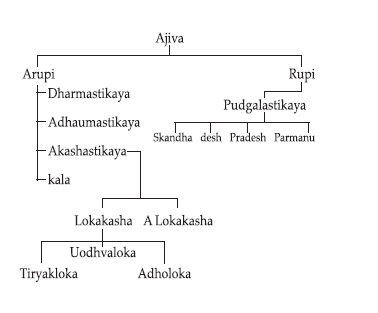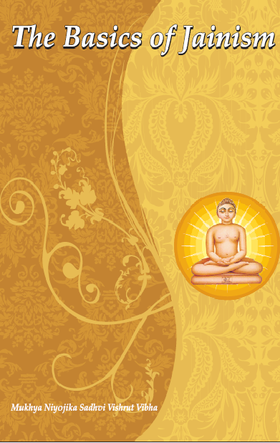Everything in the universe is either animate (Jiva) or inanimate (ajiva). Inanimate beings are devoid of consciousness, but both of these interact with each other. The worldly Jiva cannot perform any activity without the help of ajiva.
Ajiva is of two main kinds:
- Arupi Ajiva (formless)
- Rupi Ajiva (with form). It is of only one kind: (a) Pudgalastikaya
Arupi Ajiva
In the Agamas (The Jain scriptures), substances having form are called 'Murta' or 'Rupi', while those substances which have no form are called 'Amurta' or 'Arupi'. They have no colour, no smell, no taste and no touch. Although Arupi substances are invisible to our eyes, they still have their own existence.
The Kevalgyani (omniscient person) can know about the presence of these arupi substances through their direct knowledge (pratyaksh gyana). It is on the basis of the description given by the kevalgyanis that we can explain the arupi ajjva. It is of four kinds:
- Dharmastikaya (medium of motion)
- Adharmastikaya (medium of rest)
- Akashastikaya (space)
- Kala(time)
- Dharmastikaya
Dharmastikaya is a substance which acts as a medium for motion, enabling the movement of pudgal and Jiva. Just as water facilitates the movement of a fish, but does not cause it to move, likewise, movement of the Jivas is possible only through the medium of Dharmastikaya. Without this medium movement is impossible.
Dharmastikaya is a single entity. It pervades the entire cosmos, is eternal, and it neither has colour, smell, touch nor taste. It has an infinite number of 'Pradesas' (space points). Though it is stationary, it assists other objects in motion. It is an "Unmoved Mover". It is formless. No place in the cosmos is devoid of Dharmastikaya.
In the Bhagawati Sutra, Gautama asked Lord Mahavira, "How does Dharmastikaya assist the Jivas"?
Lord Mahavira replied, "If the principle of motion did not exist, movement would not be possible. How would people move? How would the waves of sound travel? The whole world would have remained stationary." - Adharmastikaya
Adharmastikaya is the substance which gives indirect assistance (without itself exercising any activity) to the repose of sentient beings and matter, as the shadow of a tree gives assistance to a traveler. Adharmastikaya is an unmoved entity which pervades the entire universe.
In Bhagwati Sutra, Gautam asked, "What is the use of Adharmastikaya for the Jivas?
Lord Mahavira replied, "If the Adharmastikaya were not to operate as the principle of rest, how would one stand and how would one sit? How would one sleep? How could one concentrate? How could one remain silent and inactive? How could one keep the eye-lids steady? The world would have constant movement. All that is steady in this universe is due to the principle of Adharmastikaya".
Dharmastikaya and Adharmastikaya are absolutely non-physical in nature. They are "amurta" or "arupi". They are neither light nor heavy nor are they objects of the senses and perception. Their existence is inferred only through their function. They are not active forces but rather, are merely passive media. The substances Dharmastikaya and Adharmastikaya are fundamental to Jain philosophy. They pervade the entire cosmos and are the distinctive characteristics of Loka (the cosmos) distinguishing it from Aloka (the supracosmos). Dharmastikaya and Adharmastikaya do not exist in Aloka. Since there are neither living beings nor matter (ajiva) in Aloka, the question of motion or rest does not arise.
- Akashastikaya
The distinguishing characteristics of Akasha (space) is its act of accommodation. All the five substances, Dharmastikaya, Adharmastikaya, Kala, Pudgal and Jiva exist and have accommodation in cosmic space. Akash however, is not contained in anything, but is self-subsistent. It is conceived as containing six substances because it is the locus of all the five substances and also of itself. Dharmastikaya and Adharmastikaya, although they exist in the entire extent of cosmic space are not independent of their locus. It is the Akasha which is the ultimate locus of everything. It has no form. It is eternal and pervasive. It is subtle substance and does not obstruct other substances. Akash is of two kinds:
- Lokakasha (cosmic)
- Alokakasha (supra cosmic)
- Lokakasha (cosmic)
Space which comprises and accommodates the six substances is called loka. The height of lokakash is fourteen rajjus (a rajju is a conceptual measure consisting of innumerable pramana yojanas, each pramana yojana being almost equivalent to eight thousand miles). In shape it resembles a supratisthika sansthan which is explained as follows:
One bowl placed convex wise (i.e. upside down) at the bottom, the second bowl placed concave wise (i.e. with the face upward) and the third one placed convex wise (like the bowl at the bottom) upon the second. The resultant configuration depicts that of the supratisthika. Lokakash consists of three parts:
- Tiryak Or Madhya Loka (horizontal or mid region)
In elevation, it is eighteen hundred yojanas and in extension, equivalent to the dimension of innumerable continents and oceans. It is the abode of the human beings, animals, birds, plants etc.
- Urdhva Lok(upper vertical)
It is a little less than seven rajjus in height and is the abode of celestial beings.
At the extreme summit of the universe is situated the siddha sila which is the abode of liberated souls. It is self luminous. All pure souls reside in eternal bliss in the siddha-sila.
- Adho Loka (lower vertical)
It is a little more than seven rajjus in dimension (depth). It is the abode of hell beings.
- Tiryak Or Madhya Loka (horizontal or mid region)
- Alokakash
Due to the absence of the medium of motion and of rest, the pure empty or void space is called Aloka. There are no animate or inanimate objects in it. It is eternal, infinite, formless and perceptible only to the omniscient.
Gautam asked Lord Mahaviraa, "What is the use of Aakash for the Jivas and ajivas"?
Lord Mahaviraa replied, "If Aakash were not present, where would the Jivas be? Where would the Dharmastikaya and Adharmastikaya pervade? Where would the complexity of pudgala be possible? The whole world would be without foundation".
- Kala:-
The final ajiva or non-living entity to be considered is Kala. It assists in bringing about the changes that take place in the universe. It is eternal, formless and infinite.
Kala is to be inferred from duration, transformation of things into various modes, action, movement, priority and posteriority.
The Theory of Ajiva
Why does every thing change? Why is there newness or oldness? Why is there a succession of events at all? All these are due to the substance called Kala.
Just as the pedal under a potter's wheel helps in the movement of the wheel without compelling it to move, similarly time assists the changes produced in the substances, though it does not compel them to change. The time substance is invisible to human eyes, but it is cognized by the omniscients.
Samaya (instant, lsec), avalika (innumerable samaya), muhurta (48 minutes), ahoratra (day and night), paksa (fortnight), masa (a month), samvatsara (a year), yuga (a cycle of twelve years), playa, sagara, avsarpani and pudgal paravartana are the traditional division of time.
Rupi Ajiva:
Rupi ajiva is of one kind:- Pudgalastikaya
Pudgalastikaya (physical order of existence of matter):What is possessed of touch, taste, odour and colour is called Pudgalastikaya. The term pudgal has two parts-"Pud" and "Gala". Pud refers to integration i.e. fission. 'Gala' refers to disintegration or decomposition. Substances which have the characteristics of constant fusion and fission are styled as Pudgala.
Pudgala has form, so it can be experienced through the sense organs. Dharmastikaya, Adharmastikayas, Akashastikaya and Kala cannot be perceived because they are formless.
Pudgalastikaya is also possessed of the following characteristics:- sound, integration subtlety, extensity, configuration, disintegration, darkness, reflection, hot effulgence, cold effulgence and lustre etc.
Pudgal can be categorized into four groups ranging from its most subtle forms:
- Skandha (aggregated compound)
- Desh (traction)
- Pradesh (point)
- Parmanu (the ultimate atom)
- Skandha
An aggregated compound is the integrated conglomeration of two to an infinite number. For instance, the conglomeration of two parmanu gives rise to a compound of two pradeshas (atomic points). In the same way, we can get the compounds of three or ten or an uncountable or infinite number of paramanus.
- Desh: An imaginary division of an entity.
- Pradesh
The smallest desh (division) which is further indivisible. Like desh, pradesh is also an intellectual division. It is an undetached part of a thing, the dimension of which is identical to that of a parmanu. A parmanu however, being a separate entity, is different from pradesh.
- Parmanu
- Taste has five varieties viz.
- Colour is of five kinds viz.
- Smell has two varieties, viz,
(1) Agreeable (sugandh) and (2) Disagreeable (durgandha)
- There are eight types of touch viz;
(1) Karkasa (hard), (2) Mridu (soft), (3) Guru (heavy), (4) Laghu (light), (5) Sita (cool), (6) Usna (warm), (7) Snighdha (viscous), and (8) Ruksa (dry).
It is an indivisible particle of matter. It is said, "The parmanu is the only ultimate cause of material bodies and is subtle and eternal. It has one kind of taste, one kind of smell, one kind of colour, and two kinds of touch. Its existence is inferred from its material bodies".
(1) Tikta (bitter), (2) Katu (acrid), (3) Kasaya (astringent), (4) Amla (sour), (5) Madhura (sweet).
(1) Krisna (black), (2) Nila (blue, (3) Rakta (red), (4) Pila (yellow) and (5) Sukla (white).
These are five Ajiva entities in the universe. Jain philosophy believes that the basic substances of the universe cannot be created out of anything. All the substances of the universe have always existed. They are eternal, only their modes change. The universe has no beginning and no end. Nothing and no one created the universe, nobody protects it and nobody will bring it to an end. The universe is governed by universal laws.

